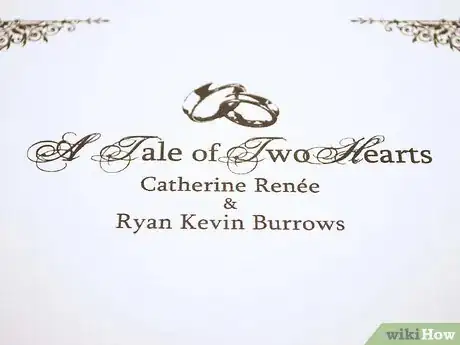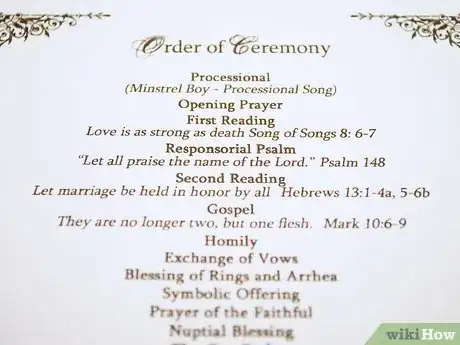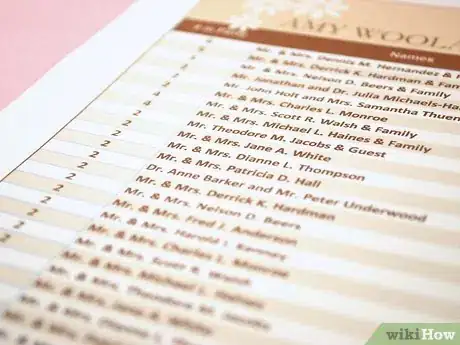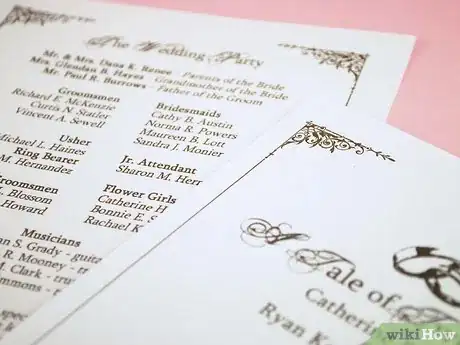wikiHow is a “wiki,” similar to Wikipedia, which means that many of our articles are co-written by multiple authors. To create this article, volunteer authors worked to edit and improve it over time.
This article has been viewed 62,590 times.
Learn more...
A personal wedding ceremony booklet helps wedding guests feel like part of the ceremony. A personal wedding ceremony booklet, often referred to as a wedding program or wedding bulletin, includes information about the bride and groom, wedding party and family. It also provides information to help guests follow the ceremony, understand the traditions incorporated in the wedding, and participate in the ceremony as applicable. Wedding guests may take the booklet home as a keepsake of the event. Use these tips to make a personal wedding ceremony booklet.
Steps
Determine What Information to Include in Your Personal Wedding Ceremony Booklet
-
1Provide basic information about the wedding. The wedding ceremony booklet should include the full names of the bride and groom, the wedding date and time, and the city, state and venue where the wedding is being held. This information is usually on the cover of the booklet.
-
2List the elements and order of the wedding ceremony. The ceremony booklet includes information about the actual ceremony so guests can follow along and participate. The booklet may list traditional parts of a wedding ceremony, such as the procession, invocation, declaration of intent, vows exchange, ring exchange, pronouncement and recession.
- Include the names of musical selections, composers and performers. If the musical selections are to be sung by the wedding guests, include the words to the songs or indicate where the song selections can be found. For example, if the wedding is held in a church, the ceremony booklet may refer guests to the pew hymnals.
- List the name, source and authorship of any readings, as well as the name of each reader.
- Include words to all prayers or sung responses. For example, if the congregation will recite the Lord's Prayer as part of a Christian wedding ceremony, include the words to the prayer in the ceremony program. If Holy Communion will be part of a Catholic wedding ceremony, include the sung responses in the ceremony bulletin. This encourages active participation by all wedding guests.
- Indicate movements guests will make during the wedding ceremony. For example, note when guests stand, sit or kneel during the ceremony.
- Provide explanations for religious and cultural traditions, rituals or customs featured in the ceremony. Write a brief explanation, including the history and background of the ritual and why it is significant to your wedding, to inform guests who do not share your culture or religion. For example, explain the symbolism of jumping a broom or breaking a wine glass if your wedding ceremony includes these traditions.
Advertisement -
3Include personal information about the bride and groom. The wedding ceremony booklet provides an opportunity to share personal information about the couple.
- Share the story of how you met and how your relationship grew. Include a few special memories or funny stories about your relationship.
- Consider including favorite photographs, poems, song lyrics or quotes.
- Include sentimental or significant information about the wedding details. List the bride's "something old, something new" accessories, or explain the significance of heirloom candlesticks, a family Bible or a bridal canopy used in the ceremony.
-
4Provide information about the wedding party, family, musicians, readers and officiant. Include the first and last names of all participants in the wedding ceremony, including the officiant, matron/maid of honor, best man, bridesmaids, groomsmen, ushers, flower girls, ringer bearers, vocalists, musicians, greeters and readers. Include the first and last names of parents and grandparents of the bride and groom.
- Include information about the relationship of each person to the bride or groom. For example, list the best man with his full name and his relationship to the groom. (Joe Smith, Best Man and college friend of the groom) The guests will feel more included in the celebration if they know some information about the wedding party and participants.
- Honor deceased loved ones with a special note in the wedding ceremony booklet.
-
5Include a thank you note to parents and guests. Many wedding ceremony booklets include a thank you note to the parents of the bride and groom, as well as one to the wedding guests. The note does not have to be lengthy, but should express sincere appreciation for being a part of the couple's wedding day.
-
6Include any special instructions related to the wedding ceremony or reception. The ceremony bulletin provides an ideal place to include additional instructions about the wedding day. For example, remind your guests that maps to the reception are located by the doors of the venue, or reiterate that flash photography is not permitted during the ceremony.
Design, Assemble and Distribute the Personal Wedding Ceremony Booklets
-
1Estimate how many wedding ceremony programs to make. Most wedding etiquette experts suggest providing 1 ceremony program per couple and 1 per single guest. Plan to make at least 20 extras as keepsakes for the wedding party and family members.
-
2Design the personal wedding ceremony booklet. There are several different options for wedding booklet formats, such as a tri-fold brochure, single piece of large cardstock or multi-page booklet. The wedding booklet should coordinate with the wedding invitations and other stationery.
- Utilize a publishing or word processing software program to design the wedding booklets. Some programs include design templates for wedding programs and other similar printed pieces.
- Incorporate colors, graphic elements and fonts that coordinate with or complement the wedding invitations. If your wedding has a theme, use the wedding ceremony booklet to carry out the theme. For example, if your wedding incorporates a beach theme, include seashell graphics on the ceremony program. If you wedding colors are black and white, consider wrapping the ceremony booklets with a black satin ribbon.
-
3Purchase paper and supplies to make the personal wedding ceremony booklet. Office supply and paper vendors offer many types of paper in different weights and colors. Select a paper that is appropriate for the type of booklet you are making. For example, if you are making a multi-page booklet, choose a mid-weight paper that folds easily, rather than a heavy cardstock. If you are creating a 1-page panel card, your best choice would be a cardstock that won't bend easily. Ask your local paper supplier about the best paper choice for your booklet design.
- Purchase any other supplies required to make the wedding ceremony booklets. If you are using ribbon to hold a multi-page booklet together, purchase the ribbon. Don't forget other supplies that may be necessary, such as paper trimmers, scissors, adhesive and hole punches. If you will be printing the booklets using your home printer, be sure to purchase extra ink cartridges.
-
4Assemble the personal wedding ceremony booklet. Depending on how labor-intensive your wedding ceremony booklet is, assembling the programs can take a few minutes or a few hours. Consider asking your family or bridal party to help you assemble the booklets.
-
5Present the personal wedding ceremony booklets. Because wedding programs can be any shape or size, the presentation may vary. Consider filling a wicker basket, antique tray or glass bowl with the booklets, and place them at the entrance to your ceremony venue.
- Ask a family member or friend to greet wedding guests as they arrive and hand out the wedding ceremony booklets. This ensures that each couple gets 1 booklet and you won't run out of booklets before all of the guests arrive. Ushers tend to be busy seating guests, so a designated greeter or program attendant is helpful in distributing the booklets.
Warnings
- Ask several trusted friends or family members to proofread your wedding ceremony booklet before printing it. Pay special attention to the spelling of all names, and make sure there are no grammatical errors in the program.⧼thumbs_response⧽





































































